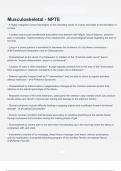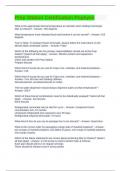STUVIA 2024/2025
Musculoskeletal - NPTE
- A highly malignant cancer that begins in the medullary cavity of a bone and leads to the formation of
a mass
- A patient status post transfemoral amputation may present with fatigue, loss of balance, phantom
pain or sensation, hypersensitivity of the residual limb, and psychological issues regarding the loss of
the limb
- Lying in a prone position is beneficial to decrease the incidence of a hip flexion contracture -
✔✔Transfemoral Amputation due to Osteosarcoma
- Characterized as the result of compression or irritation to the *proximal sciatic nerve* due to
piriformis *muscle inflammation, spasm or contracture*
- Location of *pain is often imprecise*, though typically presents first in the area of the *mid-buttock
then progresses to radicular complaints in the sciatic nerve distribution*
- Patients typically *respond well to PT interventions* and are able to return to regular activities
without restriction' - ✔✔Piriformis Syndrome
%
- Characterized by inflammation or degenerative changes at the common extensor tendon that
attaches to the lateral epicondyle of the elbow
- Repeated overuse of the wrist extensors, particularly the extensor carpi radialis brevis can produce
tensile stress and result in microscopic tearing and damage to the extensor tendon
- Clinical symptoms include difficulty holding or gripping objects and insufficient forearm functional
strength - ✔✔Lateral Epicondylitis
- Chronic overuse condition that develops secondary to repetitive stretching of the plantar fascia
through excessive foot pronation during the loading phase of gait
- Characterized by severe pain in the heel when first standing up in the morning (when the fascia is
contracted, stiff, and cold)
- Intervention consists of ice massage, deep friction massage, heel insert, orthotic prescription,
activity modification, and gentle stretching program of the Achilles Tendon and plantar fascia -
✔✔Plantar Fasciitis
stuvia
, STUVIA 2024/2025
- Condition in which *loss of blood flow to subchondral bone* causes a *piece of bone and its
associated cartilage to crack and separate* away from the end of the bone
- Symptoms may include *pain with functional activities, joint popping or locking, weakness, swelling,
and decreased ROM*
- *X-ray* imaging can be used to confirm the diagnosis - ✔✔Osteochondritis Dissecans
- Females are at greater risk than males with the most common age ranging from 20-40 years of age
- Clinical presentation includes pain (persistent or recurring), muscle spasm, abnormal or limited jaw
motion, headache, and tinnitus
- Intervention includes patient education, posture retraining, and modalities such as moist heat, ice,
biofeedback, ultrasound, electrostimulation, TENS, and massage - ✔✔Temporomandibular Joint
Dysfunction
- May occur as a result of acute or cumulative trauma to the lateral hip causing irritation to the
trochanteric bursa
%
- Causative factors may include a true or functional leg length discrepancy, history of lateral hip
surgery, and participation in sports with significant running or contact
- Patients typically respond well to conservative interventions and should be able to return fully to
their prior level of function including sport activity - ✔✔Trochanteric Bursitis
- May occur as a result of an acute traumatic incident or due to a chronic degenerative pathology
such as chronic supraspinatus tendonitis
- The drop arm test and empty can test can assist in identifying supraspinatus pathology, which may
be indicative of a rotator cuff tear
- Failure to adequately treat a rotator cuff tear may necessitate significant activity modifications,
additional surgical management, adhesive capsulitis or degenerative changes - ✔✔Rotator Cuff Tear
- occurs secondary to a traumatic event in which an excessive valgus force is applied to the
metacarpophalangeal joint of the thumb
stuvia
, STUVIA 2024/2025
- the therapist should perform ligament stability testing of the thumb by applying a valgus force to the
joint, with a movement of greater than 30-35 degrees indicating a complete tear of the ulnar collateral
ligament
- x-rays should be ordered to rule out the existence of a fracture or dislocation - ✔✔Ulnar Collateral
Ligament Sprain - Thumb
- Occurs with repetitive wrist or elbow motions or gripping, and is often seen in golfers or those who
play throwing or racket sports
- initial treatment consists of rest, ice, anti-inflammatory medications, massage, stretching, and
bracing to help control acute symptoms
- home care regimen consists of stretching and strengthening exercises, especially for the wrist flexor
and forearm pronator muscle groups, as well as icing to help control symptoms - ✔✔Medial
Epicondylitis
- Patients are typically over 55 and have experienced consistent pain that is not relieved through
conservative measures, limiting patient's functional mobility
%
- Posterolateral approach allows the abductor muscles to remain intact, however, there may be a
higher incidence of post-op joint instability due to the interruption of the posterior capsule
- Cemented hip replacement usually allows for PWB initially, while a non-cemented hip replacement
requires TTWB for up to 6 weeks - ✔✔Total Hip Arthroplasty
- Primary indication for TKA is the destruction of articular cartilage secondary to OA
- Post-op care may include a knee immobilizer, elevation of the limb, cryotherapy, intermittent ROM
using a CPM machine, and initiation of knee protocol exercises
- Patient education may include items such as to avoid excessive stress to the knee, squatting, quick
pivoting, using pillows under knee while in bed, and low seating - ✔✔Total Knee Arthroplasty
- Prosthetic Causes:
Prosthesis too long,
inadequate socket suspension,
excessive alignment stability,
excessive plantar flexion
stuvia
, STUVIA 2024/2025
- Amputee Causes:
Residual limb discomfort
, improper training,
fear of stubbing toe,
short residual limb,
painful hip/ residual limb - ✔✔Vaulting
- Prosthetic Causes:
Prosthesis too long,
excessive knee friction,
socket too small,
excessive plantar flexion
- Amputee Causes:
Abduction contracture,
improper training,
weak hip flexors,
lacks confidence to flex the knee,
painful anterior distal residual limb,
inability to initiate prosthetic knee flexion - ✔✔Circumducted Gait
%
- refers to a narrowing of either the lumbar vertebral or intervertebral foramen with symptoms
resulting from mechanical compression on either the spinal cord or exiting nerve roots
- symptoms include a gradual onset and worsening of chronic pain at the midline of the lumbar
region, unilateral nerve root radiculopathy, paresthesia, weakness, and diminished reflexes
- severity of symptoms reported varies widely and directly influences expectations for long-term
outcomes of physical therapy interventions - ✔✔Spinal Stenosis - Lumbar
- Surgical candidates typically have irreparable damage, deterioration, and destruction to the humeral
head and the glenoid fossa within the shoulder complex
- Surgical complications include mechanical loosening of the prosthesis, instability, rotator cuff tear,
implant failure, heterotopic ossification, and intraoperative fracture
- Life expectancy is longer for the shoulder compared to the knee or hip since the shoulder is a NWB
joint - ✔✔Total Shoulder Arthroplasty
stuvia





